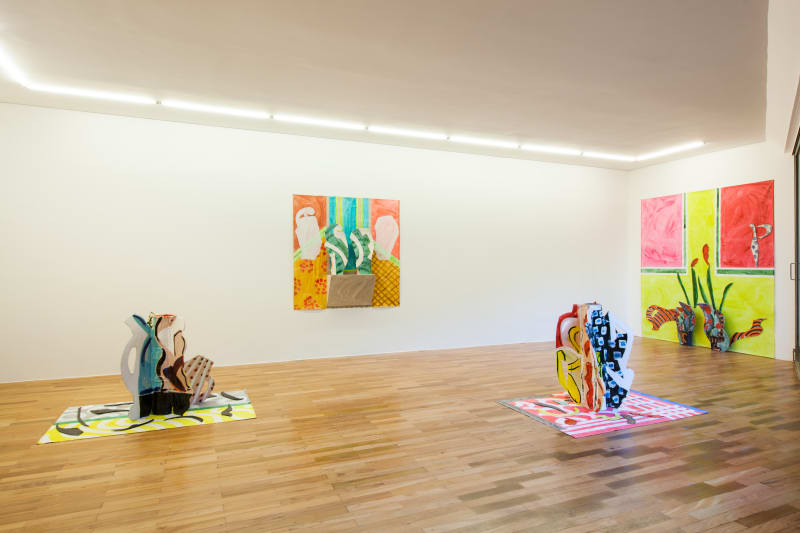Betty Woodman
The focus of her earlier production was rooted in history and the function of ceramics, the creation of vases being her signature. Though Woodman never did abandon ceramics, her more recent work has demonstrated that, her interests go beyond a concern with the function of the object, and now include painting as an essential part of her work. In Aztec Vases, a combination of painting and sculpture, the artist places a vase atop a canvas rug which has also been painted. In this way, Woodman creates an assemblage painting, in which the canvas represents a table and thevase completes the scenario. Inspired by a four-sided pre-Colombian stone sculpture, the vase makes reference to Cubist composition, which is revealed only when on lookers walk around the object.
At the same time that she evokes a tradition that is blended with the very cultural process of humanity – being that ceramics have been around since the earliest civilizations –, the artist challenges these traditional elements of mastery of ceramics by utilizing not only clay and mud, but also wood, bronze and canvas to compose her objects. The narrative constructed from this challenge to tradition is as metaphorical – if we think of the ritualistic importance of vases invarious classical cultures – as it is pragmatic, since the artist does not break with the functional character of the object;its power is in attaching meanings to the form, the concept and the function. The result of this is seen, for instance, inthe series Swedish Venus: a flat, non-cylindrical vase, incapable of containing anything, which allows the artist to leave oneside of the vase unpainted while, on the other, painting the body of a woman that emerges from the very sinuousness of the vase. This reclaiming of the ancient symbolism of the feminine is made clear in the artist's own words: Everywhere – in painting, sculpture, wall paintings, Roman mosaics, fountains – there's usually some vessel. It holds something, it's a universal symbol for woman.
Much of Woodman's inspiration descends from Roman wall paintings, which often portrayed, inside residences, trompel’oeil landscapes as representations of the outside world. But the artist inverts this dynamic; the landscape portrayed inher work is a domestic one. By placing her painted canvases on the wall, and in turn positioning them right behind avase, Betty Woodman gives us the perspective of someone outside looking in through a window, thus creating anintimate, family setting. With this three-dimensional painting, Woodman establishes a fantastic mise-en-scène out of arenewed image of the pleasures of domestic life.
Betty Woodman (*1930, Norwalk, Connecticut) lived, worked, and taught in Colorado for forty years, and now divides her time between studios in New York and Antella, Italy. Besides numerous gallery exhibitions, recent solo presentations of her work include: Places, Spaces & Things, Gardiner Museum, Toronto (2011); Roman Fresco/Pleasures and Places, American Academy in Rome (2010); L’allegra vitalità delle porcellane, Museo Delle Porcellane, Palazzo Pitti, Giardino di Boboli, Florence (2009); and Somewhere Between Denver and Naples, Denver Art Museum (2006). Her work has also recently been featured in group exhibitions including Playing House, Brooklyn Museum (2012); Postmodernism: Style and Subversion, 1970 – 1990, Victoria and Albert Museum, London (2011); Sèvres, Porcelaines Contemporaines, The Menshikov Palace, The Hermitage Museum, St. Petersburg (2010); and Dirt on Delight: Impulses that Form Clay, Institute of Contemporary Art, Philadelphia, and the Walker Art Center, Minneapolis (2009). Woodman’s artworks are featured in over fifty public collections including the Stedelijk Museum, Amsterdam; the Whitney Museum of American Art, New York; the Los Angeles County Museum of Art; and the National Gallery of Art, Washington, D.C. In fall 2015, Museo Marino Marini, Florence, will present a major traveling exhibition of Woodman’s work curated by Vincenzo De Bellis.






